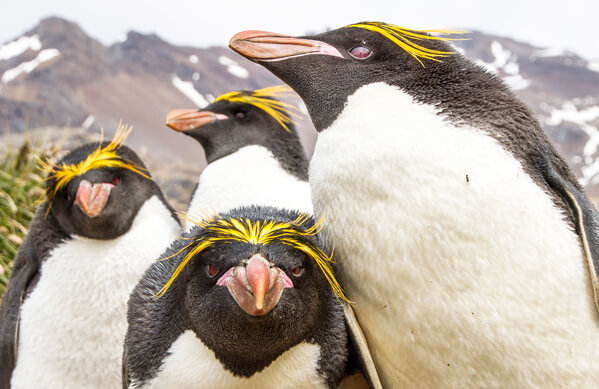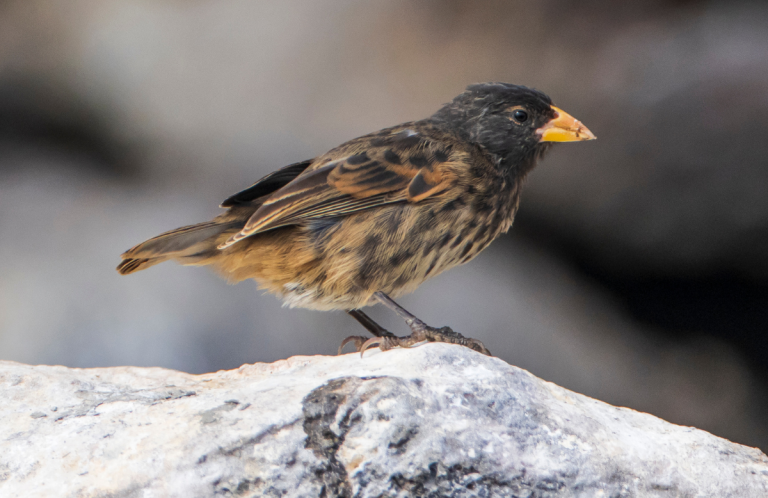
Map shows range in the Americas only.
The Macaroni Penguin is part of a larger group known as crested penguins, all found on small islands in the southernmost reaches of the world's oceans. All crested penguins are distinguished by eye-catching yellow crests and reddish eyes, beaks, and feet.
The Macaroni Penguin's bristly-looking orange-and-yellow crest is particularly impressive, reaching from the center of the bird's forehead to the back of its neck. The second word of its scientific name — chrysolophus — translates to “golden crest.”
But why is this crested penguin named after a type of pasta?
Macaroni Head
Most Americans have puzzled over the reference to macaroni in the song “Yankee Doodle Dandy,” with its famous line: “Stuck a feather in his cap and called it macaroni.” It turns out, the song isn't about someone putting pasta on his head! Instead, it's a parody: "Macaronis" were followers of a flamboyant fashion trend in 18th-century Europe, where upper-class gentlemen sported huge, elaborate hats and wigs adorned with ornate feathers.
When English sailors first reached the Falkland Islands and saw these gold-crested penguins, they called them "macaronis" — the perfect name for this dapper bird with the elaborate crest.
American Penguins — Barely
The Macaroni Penguin's range barely reaches the Americas, where it can be seen around the coasts of Tierra del Fuego in southern Argentina and Chile. The bulk of the population dwells outside of the Americas, breeding on small islands in the sub-Antarctic regions of the South Atlantic and Indian Oceans.
Six other penguin species inhabit South America, including the Galápagos Penguin, which ranges the farthest north, and the King Penguin, which takes the title of world's second-largest penguin species, right behind the Emperor Penguin.
Dapper Divers
Outside of its roughly five-month breeding season, the Macaroni Penguin spends much of its life at sea, at times traveling more than 1,000 miles from its nesting colonies. As with other penguins, its wings have evolved into effective flippers, allowing this flightless bird to dive and swim underwater at depths of 50 to 200 feet in pursuit of its prey. Like other seagoing (pelagic) species such as the Ringed Storm-Petrel and White-tailed Tropicbird, it feeds heavily on krill, supplementing with squid and fish as opportunity arises.
Macaroni Penguins nest in huge, noisy breeding colonies. Males arrive first to stake out territory and employ a variety of display behaviors and calls to attract a female. Pairs often perform an “ecstatic display,” bowing forward while making peculiar throbbing sounds, then extending heads and necks straight up while waving their heads from side to side and braying loudly.
Sign up for ABC's eNews to learn how you can help protect birds
Female Macaroni Penguins lay two eggs, which are incubated by both the male and female for 33 to 40 days, with each shift lasting a week to 12 days. Strangely enough, the first egg is always smaller and is usually rejected once the larger second egg is laid. The reasons for this extreme form of brood reduction are unclear; researchers theorize that the first, smaller egg is an "insurance policy" against the failure to lay a second. In any case, only one chick usually ends up being raised.

Macaroni Penguin by Jame Stone76, Shutterstock
After they hatch, the downy young hang around in groups called creches for a bit longer than three weeks. By congregating this way, they likely benefit from safety in numbers, staving off aggressive, unrelated adults; predators such as Brown Skuas; and exposure to harsh weather. Young Macaroni Penguins fledge at approximately two months old.
Penguin Awareness Needed
Although the Macaroni Penguin is the most numerous of the world's penguin species, widespread population declines since the 1970s have caused the International Union for Conservation of Nature (IUCN) to classify them as Vulnerable on the Red List.
Man-made threats faced by this penguin (and all penguin species) include commercial fishing, introduced predators such as rats and cats on their nesting islands, oil and plastic pollution, and, most significantly, ocean warming likely caused by climate change.
January 20 is International Penguin Awareness Day, a great time to consider ways you can contribute to the conservation of these unique birds. Visit ABC's website for ways you can get involved in saving bird species, from those as remote as the Macaroni Penguin to such backyard favorites as the Dark-eyed Junco.
Donate to support ABC's conservation mission!



















































